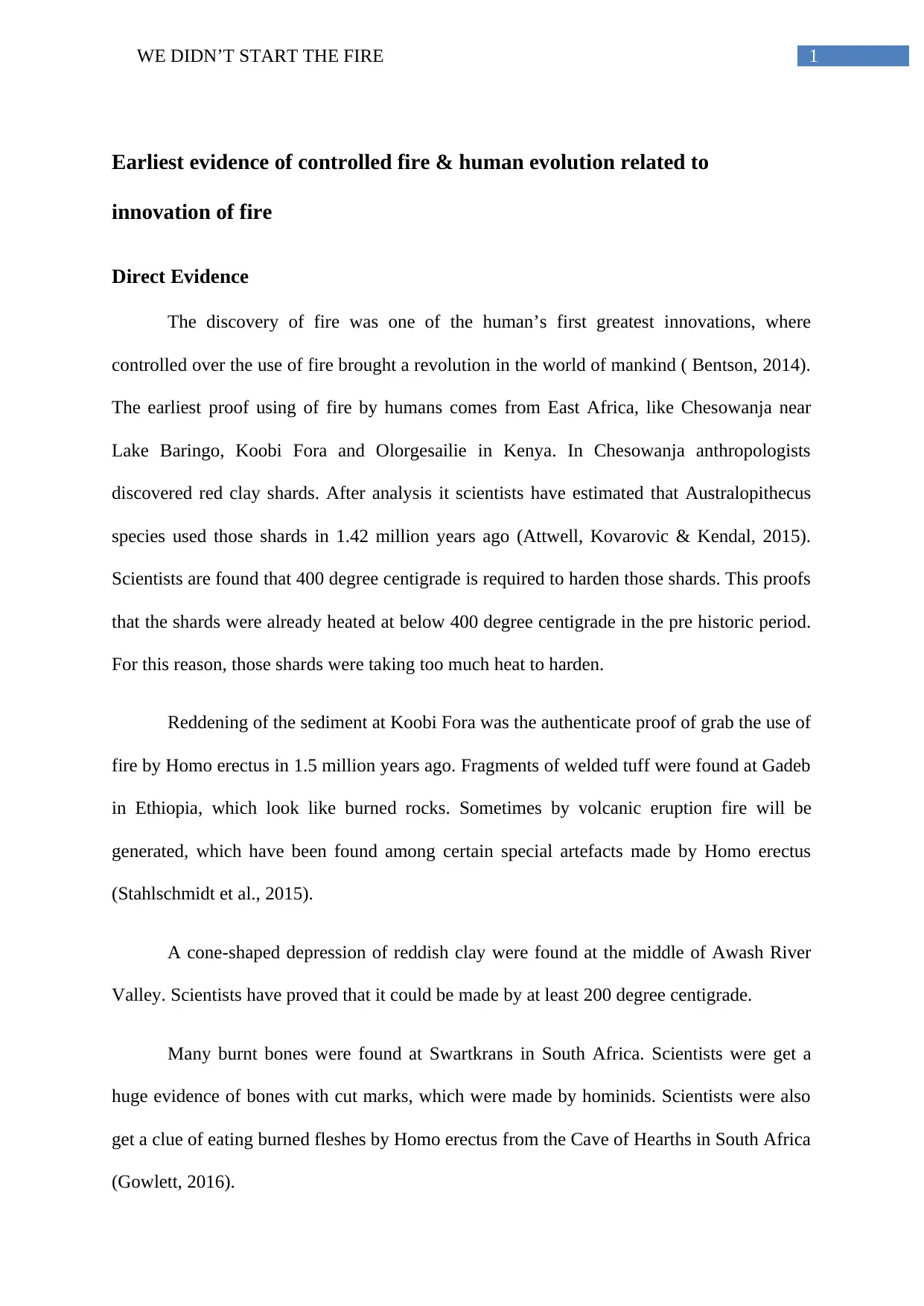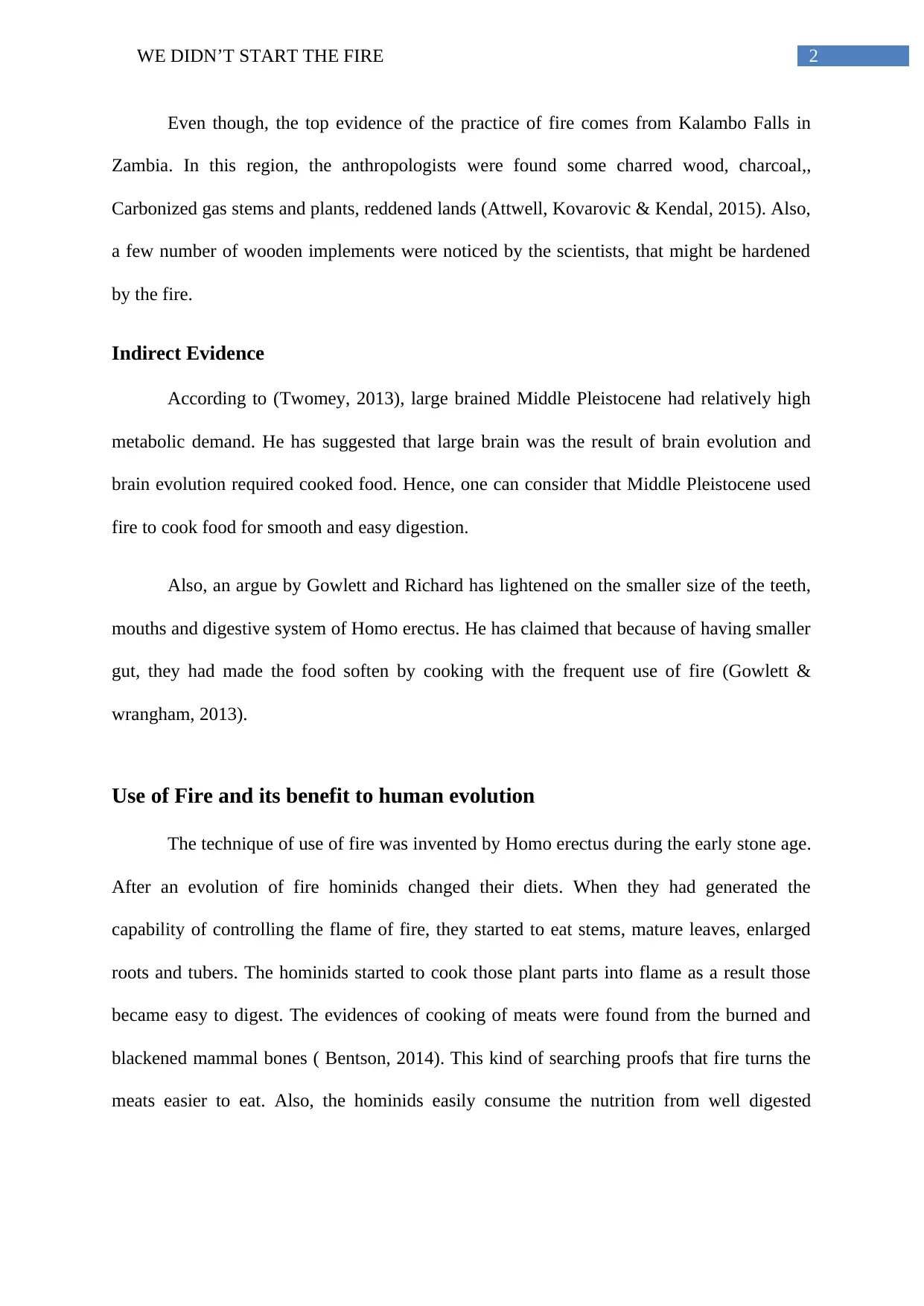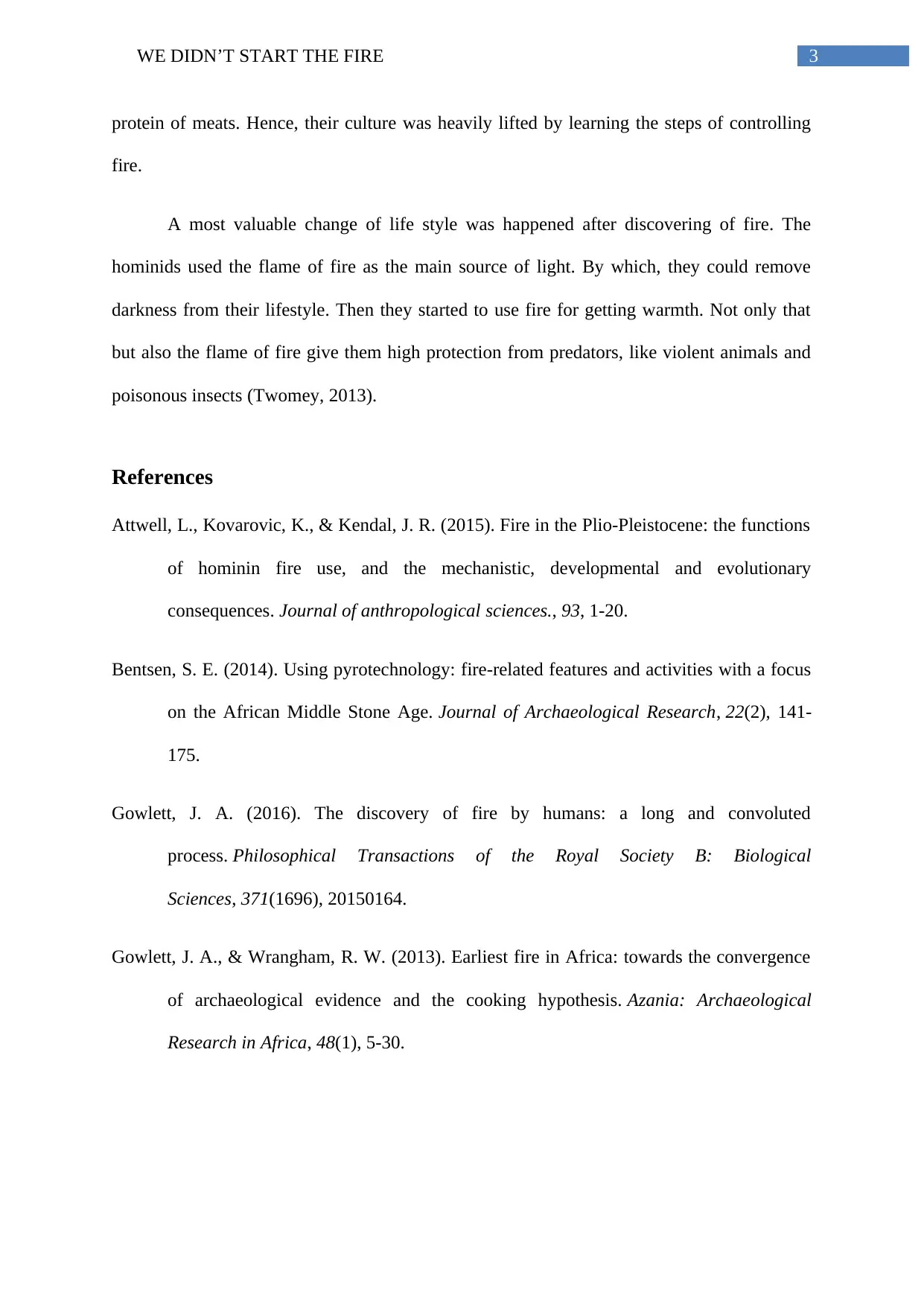The Evolution of Fire Use: Evidence, Benefits, and Impact on Humans
VerifiedAdded on 2022/11/23
|5
|1025
|433
Essay
AI Summary
This assignment explores the discovery and use of fire by early humans, focusing on the evidence from the Paleolithic periods. It examines direct evidence like red clay shards and burned bones, and indirect evidence suggesting cooking practices. The essay highlights the benefits of fire, including its role in changing diets, providing light and warmth, and offering protection. The work discusses the impact of fire on human evolution, particularly the Homo erectus, and references key studies and archaeological findings from sites in Africa and other regions. The assignment provides an overview of the topic and the debates surrounding the use of fire by early humans.

Running head: WE DIDN’T START THE FIRE
WE DIDN’T START THE FIRE
Name of the Student
Name of the University
Author Note
WE DIDN’T START THE FIRE
Name of the Student
Name of the University
Author Note
Secure Best Marks with AI Grader
Need help grading? Try our AI Grader for instant feedback on your assignments.

1WE DIDN’T START THE FIRE
Earliest evidence of controlled fire & human evolution related to
innovation of fire
Direct Evidence
The discovery of fire was one of the human’s first greatest innovations, where
controlled over the use of fire brought a revolution in the world of mankind ( Bentson, 2014).
The earliest proof using of fire by humans comes from East Africa, like Chesowanja near
Lake Baringo, Koobi Fora and Olorgesailie in Kenya. In Chesowanja anthropologists
discovered red clay shards. After analysis it scientists have estimated that Australopithecus
species used those shards in 1.42 million years ago (Attwell, Kovarovic & Kendal, 2015).
Scientists are found that 400 degree centigrade is required to harden those shards. This proofs
that the shards were already heated at below 400 degree centigrade in the pre historic period.
For this reason, those shards were taking too much heat to harden.
Reddening of the sediment at Koobi Fora was the authenticate proof of grab the use of
fire by Homo erectus in 1.5 million years ago. Fragments of welded tuff were found at Gadeb
in Ethiopia, which look like burned rocks. Sometimes by volcanic eruption fire will be
generated, which have been found among certain special artefacts made by Homo erectus
(Stahlschmidt et al., 2015).
A cone-shaped depression of reddish clay were found at the middle of Awash River
Valley. Scientists have proved that it could be made by at least 200 degree centigrade.
Many burnt bones were found at Swartkrans in South Africa. Scientists were get a
huge evidence of bones with cut marks, which were made by hominids. Scientists were also
get a clue of eating burned fleshes by Homo erectus from the Cave of Hearths in South Africa
(Gowlett, 2016).
Earliest evidence of controlled fire & human evolution related to
innovation of fire
Direct Evidence
The discovery of fire was one of the human’s first greatest innovations, where
controlled over the use of fire brought a revolution in the world of mankind ( Bentson, 2014).
The earliest proof using of fire by humans comes from East Africa, like Chesowanja near
Lake Baringo, Koobi Fora and Olorgesailie in Kenya. In Chesowanja anthropologists
discovered red clay shards. After analysis it scientists have estimated that Australopithecus
species used those shards in 1.42 million years ago (Attwell, Kovarovic & Kendal, 2015).
Scientists are found that 400 degree centigrade is required to harden those shards. This proofs
that the shards were already heated at below 400 degree centigrade in the pre historic period.
For this reason, those shards were taking too much heat to harden.
Reddening of the sediment at Koobi Fora was the authenticate proof of grab the use of
fire by Homo erectus in 1.5 million years ago. Fragments of welded tuff were found at Gadeb
in Ethiopia, which look like burned rocks. Sometimes by volcanic eruption fire will be
generated, which have been found among certain special artefacts made by Homo erectus
(Stahlschmidt et al., 2015).
A cone-shaped depression of reddish clay were found at the middle of Awash River
Valley. Scientists have proved that it could be made by at least 200 degree centigrade.
Many burnt bones were found at Swartkrans in South Africa. Scientists were get a
huge evidence of bones with cut marks, which were made by hominids. Scientists were also
get a clue of eating burned fleshes by Homo erectus from the Cave of Hearths in South Africa
(Gowlett, 2016).

2WE DIDN’T START THE FIRE
Even though, the top evidence of the practice of fire comes from Kalambo Falls in
Zambia. In this region, the anthropologists were found some charred wood, charcoal,,
Carbonized gas stems and plants, reddened lands (Attwell, Kovarovic & Kendal, 2015). Also,
a few number of wooden implements were noticed by the scientists, that might be hardened
by the fire.
Indirect Evidence
According to (Twomey, 2013), large brained Middle Pleistocene had relatively high
metabolic demand. He has suggested that large brain was the result of brain evolution and
brain evolution required cooked food. Hence, one can consider that Middle Pleistocene used
fire to cook food for smooth and easy digestion.
Also, an argue by Gowlett and Richard has lightened on the smaller size of the teeth,
mouths and digestive system of Homo erectus. He has claimed that because of having smaller
gut, they had made the food soften by cooking with the frequent use of fire (Gowlett &
wrangham, 2013).
Use of Fire and its benefit to human evolution
The technique of use of fire was invented by Homo erectus during the early stone age.
After an evolution of fire hominids changed their diets. When they had generated the
capability of controlling the flame of fire, they started to eat stems, mature leaves, enlarged
roots and tubers. The hominids started to cook those plant parts into flame as a result those
became easy to digest. The evidences of cooking of meats were found from the burned and
blackened mammal bones ( Bentson, 2014). This kind of searching proofs that fire turns the
meats easier to eat. Also, the hominids easily consume the nutrition from well digested
Even though, the top evidence of the practice of fire comes from Kalambo Falls in
Zambia. In this region, the anthropologists were found some charred wood, charcoal,,
Carbonized gas stems and plants, reddened lands (Attwell, Kovarovic & Kendal, 2015). Also,
a few number of wooden implements were noticed by the scientists, that might be hardened
by the fire.
Indirect Evidence
According to (Twomey, 2013), large brained Middle Pleistocene had relatively high
metabolic demand. He has suggested that large brain was the result of brain evolution and
brain evolution required cooked food. Hence, one can consider that Middle Pleistocene used
fire to cook food for smooth and easy digestion.
Also, an argue by Gowlett and Richard has lightened on the smaller size of the teeth,
mouths and digestive system of Homo erectus. He has claimed that because of having smaller
gut, they had made the food soften by cooking with the frequent use of fire (Gowlett &
wrangham, 2013).
Use of Fire and its benefit to human evolution
The technique of use of fire was invented by Homo erectus during the early stone age.
After an evolution of fire hominids changed their diets. When they had generated the
capability of controlling the flame of fire, they started to eat stems, mature leaves, enlarged
roots and tubers. The hominids started to cook those plant parts into flame as a result those
became easy to digest. The evidences of cooking of meats were found from the burned and
blackened mammal bones ( Bentson, 2014). This kind of searching proofs that fire turns the
meats easier to eat. Also, the hominids easily consume the nutrition from well digested

3WE DIDN’T START THE FIRE
protein of meats. Hence, their culture was heavily lifted by learning the steps of controlling
fire.
A most valuable change of life style was happened after discovering of fire. The
hominids used the flame of fire as the main source of light. By which, they could remove
darkness from their lifestyle. Then they started to use fire for getting warmth. Not only that
but also the flame of fire give them high protection from predators, like violent animals and
poisonous insects (Twomey, 2013).
References
Attwell, L., Kovarovic, K., & Kendal, J. R. (2015). Fire in the Plio-Pleistocene: the functions
of hominin fire use, and the mechanistic, developmental and evolutionary
consequences. Journal of anthropological sciences., 93, 1-20.
Bentsen, S. E. (2014). Using pyrotechnology: fire-related features and activities with a focus
on the African Middle Stone Age. Journal of Archaeological Research, 22(2), 141-
175.
Gowlett, J. A. (2016). The discovery of fire by humans: a long and convoluted
process. Philosophical Transactions of the Royal Society B: Biological
Sciences, 371(1696), 20150164.
Gowlett, J. A., & Wrangham, R. W. (2013). Earliest fire in Africa: towards the convergence
of archaeological evidence and the cooking hypothesis. Azania: Archaeological
Research in Africa, 48(1), 5-30.
protein of meats. Hence, their culture was heavily lifted by learning the steps of controlling
fire.
A most valuable change of life style was happened after discovering of fire. The
hominids used the flame of fire as the main source of light. By which, they could remove
darkness from their lifestyle. Then they started to use fire for getting warmth. Not only that
but also the flame of fire give them high protection from predators, like violent animals and
poisonous insects (Twomey, 2013).
References
Attwell, L., Kovarovic, K., & Kendal, J. R. (2015). Fire in the Plio-Pleistocene: the functions
of hominin fire use, and the mechanistic, developmental and evolutionary
consequences. Journal of anthropological sciences., 93, 1-20.
Bentsen, S. E. (2014). Using pyrotechnology: fire-related features and activities with a focus
on the African Middle Stone Age. Journal of Archaeological Research, 22(2), 141-
175.
Gowlett, J. A. (2016). The discovery of fire by humans: a long and convoluted
process. Philosophical Transactions of the Royal Society B: Biological
Sciences, 371(1696), 20150164.
Gowlett, J. A., & Wrangham, R. W. (2013). Earliest fire in Africa: towards the convergence
of archaeological evidence and the cooking hypothesis. Azania: Archaeological
Research in Africa, 48(1), 5-30.
Secure Best Marks with AI Grader
Need help grading? Try our AI Grader for instant feedback on your assignments.

4WE DIDN’T START THE FIRE
Stahlschmidt, M. C., Miller, C. E., Ligouis, B., Hambach, U., Goldberg, P., Berna, F., ... &
Conard, N. J. (2015). On the evidence for human use and control of fire at
Schöningen. Journal of Human Evolution, 89, 181-201.
Twomey, T. (2013). The cognitive implications of controlled fire use by early
humans. Cambridge Archaeological Journal, 23(1), 113-128.
Stahlschmidt, M. C., Miller, C. E., Ligouis, B., Hambach, U., Goldberg, P., Berna, F., ... &
Conard, N. J. (2015). On the evidence for human use and control of fire at
Schöningen. Journal of Human Evolution, 89, 181-201.
Twomey, T. (2013). The cognitive implications of controlled fire use by early
humans. Cambridge Archaeological Journal, 23(1), 113-128.
1 out of 5
Your All-in-One AI-Powered Toolkit for Academic Success.
+13062052269
info@desklib.com
Available 24*7 on WhatsApp / Email
![[object Object]](/_next/static/media/star-bottom.7253800d.svg)
Unlock your academic potential
© 2024 | Zucol Services PVT LTD | All rights reserved.